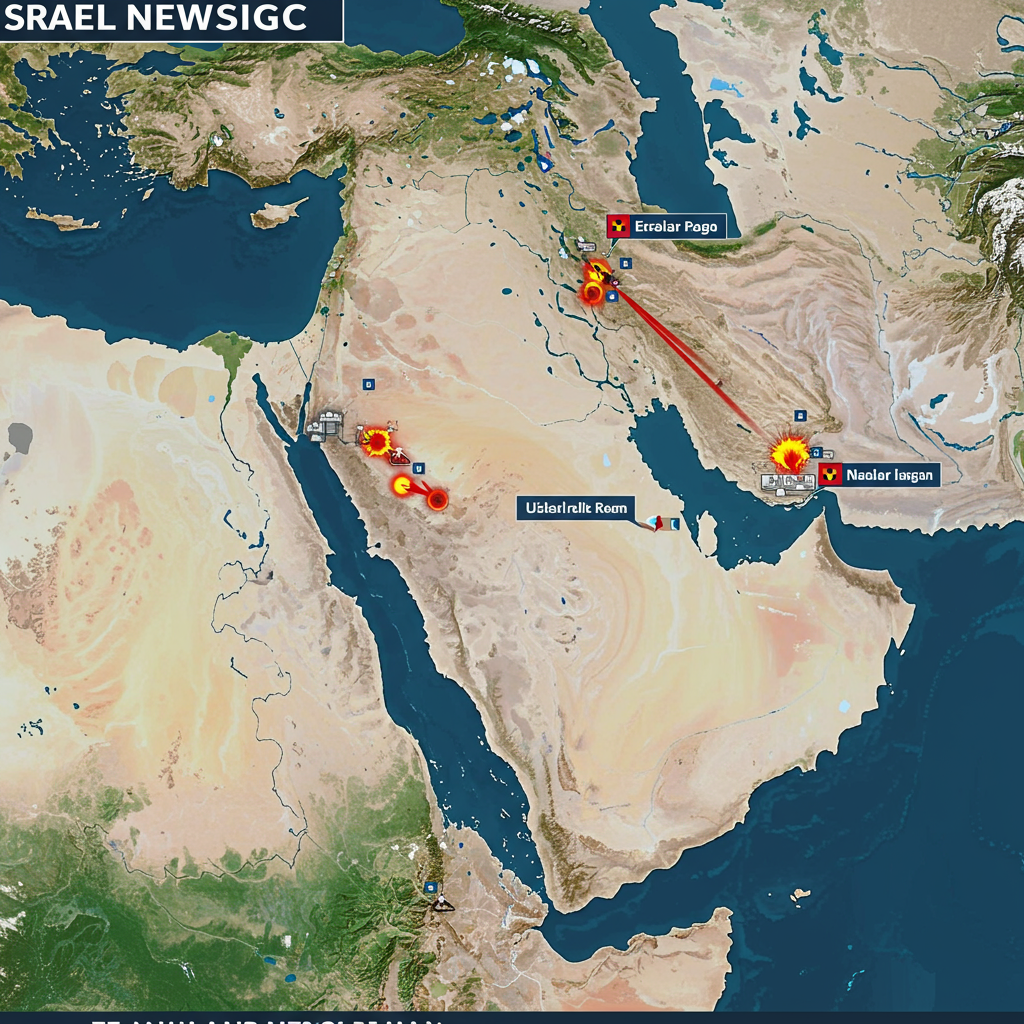The long-simmering tensions between Israel and Iran have erupted into direct, intense military conflict, marking a dangerous escalation in the Middle East. Recent days have seen unprecedented exchanges of ballistic missile and drone attacks, with Israel primarily targeting Iran’s nuclear and missile programs, and Iran launching retaliatory strikes deep into Israeli territory. This conflict, visualised through maps and satellite imagery, reveals the strategic sites under attack and the severe impact on both nations.
Israel’s Campaign Against Iran’s Capabilities
Israel’s military campaign against Iran has a stated core objective: the dismantling of Tehran’s nuclear and ballistic missile programs. For years, international bodies like the International Atomic Energy Agency (IAEA) have voiced “serious concern” over Iran’s uranium enrichment activities, particularly its enrichment up to 60% fissile purity. This level is seen by Western powers as having no credible civilian justification, as it is a short technical step away from weapons-grade material (around 90%). While Iran maintains its program is purely for peaceful purposes under the Non-Proliferation Treaty, Israel views it as an existential threat.
The latest escalation began with major Israeli aerial bombardments across Iran, reportedly involving hundreds of jets targeting military leaders, scientists, and critical infrastructure. These strikes, which commenced abruptly, aimed to deliver a significant blow to Iran’s strategic assets.
Key Iranian Targets Hit by Israeli Strikes:
Nuclear Facilities: Several key sites associated with Iran’s nuclear fuel cycle have sustained damage.
Natanz: This vast complex, including a deeply buried Fuel Enrichment Plant (FEP) designed for thousands of centrifuges, saw its critical electrical infrastructure (sub-stations, power supply, generators) destroyed. IAEA officials believe this likely caused severe damage to centrifuges operating there. The smaller, above-ground Pilot Fuel Enrichment Plant (PFEP), an R&D facility enriching uranium up to 60%, was also reportedly destroyed.
Isfahan: Strikes here damaged multiple buildings, including the Uranium Conversion Facility (UCF) and sites involved in uranium metal work. Damage to the UCF could potentially disrupt the production of uranium hexafluoride, essential feedstock for enrichment centrifuges. Mastering uranium metal technology is also a crucial step towards developing a nuclear weapon core.
Fordow: Iran’s most heavily fortified enrichment site, built deep inside a mountain, appears to have suffered little or no visible damage. Despite having fewer centrifuges than Natanz, Fordow produces the bulk of Iran’s 60% enriched uranium, leveraging a more efficient process.
Military & Missile Infrastructure: Israel also targeted Iran’s extensive ballistic missile arsenal, the largest in the Middle East. Strikes hit missile launchers (reportedly destroying around a third of Iran’s stock), silos, support units, and military bases across the country. Airports, including those in Mashhad, Mehrabad, and Tabriz (where a missile complex was hit), also came under attack.
Energy Facilities: Key energy sites, such as the South Pars gas field, storage tanks in Rey, and a fuel depot in Shahran, were also targeted.
Leadership and Personnel: Israeli strikes specifically targeted senior military commanders and nuclear scientists, aiming to disrupt the leadership and expertise driving these programs. Iran has reported significant casualties, including prominent figures, though precise numbers and identities vary across reports.
The capital, Tehran, has experienced particularly heavy bombardment, with Israeli forces claiming control of Iranian airspace following successful strikes on air defense systems. Both Israeli and US officials issued urgent calls for large-scale evacuations from the city. Initial Iranian reports indicated over 200 fatalities from the Israeli attacks, with some rights groups citing figures potentially exceeding 500 civilian deaths.
Iran’s Retaliation: Missiles Strike Israel
In response to the Israeli campaign, Iran launched waves of retaliatory missile and drone attacks directly at cities across Israel. Hundreds of projectiles were fired, stretching Israel’s multi-layered air defense systems.
Key Israeli Targets Hit by Iranian Strikes:
Strategic & Sensitive Sites: Some strikes penetrated defenses to hit highly sensitive locations. One missile landed just 300 meters from the Israeli Ministry of Defence headquarters (the Kirya) in Tel Aviv. The Weizmann Institute of Science in Rehovot, a leading research center reportedly collaborating with the military, was also targeted.
Urban Areas: Numerous cities across central and northern Israel were impacted.
The Tel Aviv metropolitan area saw widespread damage. In Ramat Gan, adjacent to Tel Aviv, strikes hit residential towers, destroying nine buildings. Petah Tikva also experienced damage to homes and commercial areas. A religious school was destroyed in Bnei Brak. Bat Yam suffered significant destruction and casualties, with nine deaths reported. Rishon LeZion also saw homes destroyed.
In northern Israel, the Bazan petrochemical complex near Haifa, the country’s largest oil refinery, was hit, forcing its shutdown. Residential buildings in Haifa were also struck.
The predominantly Palestinian town of Tamra saw a tragic strike kill four women from the same family, highlighting concerns about infrastructure like bomb shelters in certain communities.
While Israeli defenses intercepted many incoming threats, some missiles successfully bypassed the shield, causing significant damage described as exceeding anything seen in decades of confrontation with groups like Hamas or Hezbollah. Iran’s Revolutionary Guards claimed to have employed a new method to overcome Israel’s defense systems.
Israel’s Layered Defense Network
Israel relies on a sophisticated, multi-layered missile defense system developed with US support. This includes:
Iron Dome: A mobile system designed for short-range rockets, mortars, and drones (4-70 km range), protecting populated areas. It assesses threats and only intercepts those heading towards cities.
David’s Sling: Designed for medium-range threats.
- Arrow 2 & Arrow 3: Long-range and exo-atmospheric interceptors against ballistic missiles.
- www.reuters.com
- www.nbcnews.com
- www.aljazeera.com
- www.theguardian.com
- www.newsweek.com
Israeli officials reported an “80 or 90% success rate” for their defensive umbrella, acknowledging that no system is foolproof.
Escalation and Regional Impact
The exchange of strikes has resulted in tragic civilian casualties on both sides. Israeli officials report 24 Israelis killed by Iranian attacks, all civilians. Iran claims over 224 Iranians have been killed in Israeli attacks, mostly civilians, with some estimates suggesting a higher toll.
The severity and depth of the damage in Israeli cities from Iranian strikes have been notable. The conflict shows no sign of abating, with both sides issuing warnings of further escalation. Israeli officials have threatened severe reprisals against Tehran if missile attacks continue, while Iran vows intensified and more powerful strikes.
Amidst these escalating hostilities, regional tensions are soaring. The US State Department has elevated travel warnings for Israel and other Middle Eastern nations to the highest levels (“Do Not Travel”), citing the risk of armed conflict and attacks. The possibility of direct US military involvement against Iran looms, a factor that could dramatically increase risks across the entire region. The security situation remains highly volatile and rapidly evolving.



